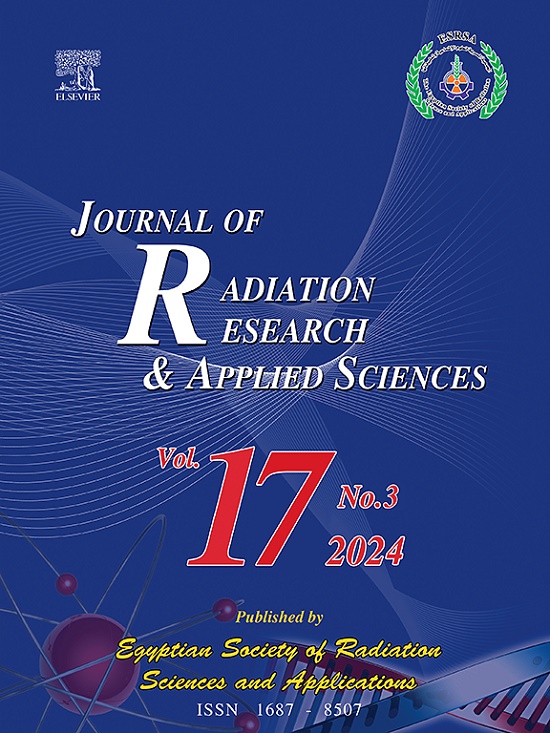Radiomics and machine learning for predicting mycobacterial response to proteasome inhibition: A multi-center CT imaging study
IF 1.7
4区 综合性期刊
Q2 MULTIDISCIPLINARY SCIENCES
Journal of Radiation Research and Applied Sciences
Pub Date : 2025-05-31
DOI:10.1016/j.jrras.2025.101628
引用次数: 0
Abstract
Objective
This study aimed to develop a non-invasive imaging-based model to predict the response of mycobacterial infections to proteasome inhibition in lung cancer patients.
Materials and methods
This retrospective, multi-center study included 1480 lung cancer patients with concurrent Mycobacterium tuberculosis infection, recruited from eight hospitals. All patients underwent chest CT imaging and had proteasome activity measured in tumor tissues. Tumor regions were manually segmented, and radiomic features were extracted. Features with high inter-rater reliability were selected using Intraclass Correlation Coefficients (ICCs), and Least Absolute Shrinkage and Selection Operator (LASSO) regression was applied to reduce feature redundancy. Four machine learning algorithms were trained and evaluated using cross-validation. The model with the highest performance was selected to construct a predictive nomogram. Decision Curve Analysis (DCA) was performed to quantify clinical benefit, and ComBat harmonization was applied to address inter-scanner variability.
Results
The Random Forest classifier achieved the best performance, with an area under the AUC of 0.91 and an accuracy of 86.2 %. The model demonstrated a sensitivity of 84.9 % and a specificity of 87.4 %. Radiomic features such as wavelet-transformed texture entropy and GLCM correlation showed strong associations with tumor proteasome activity (correlation coefficient r = 0.78, p < 0.001). The developed nomogram, integrating radiomic features and clinical variables, yielded robust predictive accuracy (Hosmer-Lemeshow p = 0.27). External validation on an independent cohort (n = 92) confirmed generalizability with an AUC of 0.88. DCA demonstrated superior net clinical benefit compared to conventional biomarkers.
Conclusions
Our findings support the use of radiomics and machine learning to predict immune response in lung cancer patients with tuberculosis, providing a promising, non-invasive tool for precision medicine. However, as the study population was limited to lung cancer patients with TB, further validation in broader TB cohorts without cancer is necessary to assess the generalizability of the findings.
放射组学和机器学习预测分枝杆菌对蛋白酶体抑制的反应:一项多中心CT成像研究
目的建立一种无创影像学模型,预测肺癌患者分枝杆菌感染对蛋白酶体抑制的反应。材料与方法本研究是一项回顾性、多中心研究,纳入了来自8家医院的1480例合并结核分枝杆菌感染的肺癌患者。所有患者均接受胸部CT成像,并在肿瘤组织中测量蛋白酶体活性。人工分割肿瘤区域,提取放射学特征。使用类内相关系数(ICCs)选择具有高可靠性的特征,并使用最小绝对收缩和选择算子(LASSO)回归来减少特征冗余。使用交叉验证对四种机器学习算法进行了训练和评估。选取性能最高的模型构建预测模态图。决策曲线分析(DCA)用于量化临床效益,战斗协调(ComBat harmonization)用于解决扫描仪间的可变性。结果随机森林分类器在AUC下的分类面积为0.91,准确率为86.2%。该模型的敏感性为84.9%,特异性为87.4%。放射学特征如小波变换纹理熵和GLCM相关性与肿瘤蛋白酶体活性有很强的相关性(相关系数r = 0.78, p <;0.001)。综合放射学特征和临床变量,所开发的nomogram获得了稳健的预测准确性(Hosmer-Lemeshow p = 0.27)。独立队列(n = 92)的外部验证证实了该方法的普遍性,AUC为0.88。与传统生物标志物相比,DCA表现出更优越的净临床效益。结论我们的研究结果支持使用放射组学和机器学习来预测肺癌合并结核病患者的免疫反应,为精准医疗提供了一种有前途的非侵入性工具。然而,由于研究人群仅限于肺癌结核病患者,因此有必要在更广泛的非癌症结核病队列中进一步验证,以评估研究结果的普遍性。
本文章由计算机程序翻译,如有差异,请以英文原文为准。
求助全文
约1分钟内获得全文
求助全文
来源期刊

Journal of Radiation Research and Applied Sciences
MULTIDISCIPLINARY SCIENCES-
自引率
5.90%
发文量
130
审稿时长
16 weeks
期刊介绍:
Journal of Radiation Research and Applied Sciences provides a high quality medium for the publication of substantial, original and scientific and technological papers on the development and applications of nuclear, radiation and isotopes in biology, medicine, drugs, biochemistry, microbiology, agriculture, entomology, food technology, chemistry, physics, solid states, engineering, environmental and applied sciences.
 求助内容:
求助内容: 应助结果提醒方式:
应助结果提醒方式:


